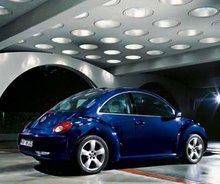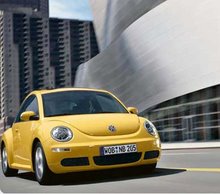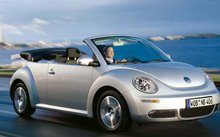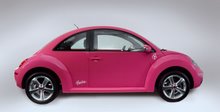 The Volkswagen Type 1, more commonly known as the Beetle, Fusca (in Brazil and Uruguay), Coccinelle or Cox (French), Vocho (Spanish), Bug, Volky or Käfer (German), Escarabajo (beetle in Spanish), Carocha (in Portugal) is an economy car produced by the German automaker Volkswagen from 1938 until 1975. Although the names "Beetle" and "Bug" were quickly adopted by the public, it was not until August of 1967 that VW themselves began using the name Beetle in marketing materials. It had previously been known only as either the "Type I" or as the 1200 (twelve-hundred), 1300 (thirteen-hundred) or 1500 (fifteen-hundred), which had been the names under which the vehicle was marketed in Europe prior to 1967; the numbers denoted the vehicle's engine size in cubic centimeters. In 1998, many years after the original model had been dropped from the lineup in most of the world (it continued in Mexico and a handful of other countries until 2003) VW introduced the "New Beetle" (built on a Volkswagen Golf platform), bearing a strong resemblance to the original.
The Volkswagen Type 1, more commonly known as the Beetle, Fusca (in Brazil and Uruguay), Coccinelle or Cox (French), Vocho (Spanish), Bug, Volky or Käfer (German), Escarabajo (beetle in Spanish), Carocha (in Portugal) is an economy car produced by the German automaker Volkswagen from 1938 until 1975. Although the names "Beetle" and "Bug" were quickly adopted by the public, it was not until August of 1967 that VW themselves began using the name Beetle in marketing materials. It had previously been known only as either the "Type I" or as the 1200 (twelve-hundred), 1300 (thirteen-hundred) or 1500 (fifteen-hundred), which had been the names under which the vehicle was marketed in Europe prior to 1967; the numbers denoted the vehicle's engine size in cubic centimeters. In 1998, many years after the original model had been dropped from the lineup in most of the world (it continued in Mexico and a handful of other countries until 2003) VW introduced the "New Beetle" (built on a Volkswagen Golf platform), bearing a strong resemblance to the original.Although widely disdained for its unusual styling, weak power, rough ride, and high noise levels, it was ultimately among the longest and most produced automobiles for a single design. It remained a top seller even as rear-wheel drive conventional subcompacts were refined until ultimately replaced by front-wheel drive models. Most other nameplates are applied to succeeding generations of redesigned platforms, including its replacement, the Golf / Rabbit. The Beetle car was the benchmark for both generations of American compact cars such as the Chevrolet Corvair and subcompact cars such as the Ford Pinto and Chevrolet Vega. In the international poll for the award of the world's most influential car of the twentieth century the Beetle came fourth after the Ford Model T, the Mini and the Citroën DS, but the Beetle is far more recognizable and familiar to more people than any other passenger automobile.







